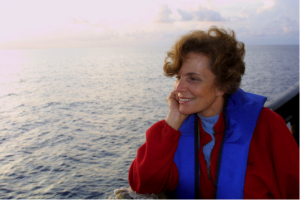
A scientist who has enjoyed “a lifetime of splashing around the oceans of the world,” Dr. Sylvia Earle — or, as the New Yorker has called her, ‘Her Deepness’ — recently spoke to a full auditorium at the Norwalk Maritime Aquarium, issuing a call to make sustainable seas a reality.
At 77 years old, Dr. Earle has been to the bottom of the ocean and back, served as chief scientist of the National Oceanic and Atmospheric Administration (NOAA), is an explorer-in-residence at National Geographic, and has founded SEAlliance, Mission Blue, and Deep Ocean Exploration and Research, Inc.
Like many marine scientists, Earle’s ocean fixation was born the day she donned SCUBA gear for the first time. She began diving in the 1950s, receiving just two words of instruction, “Breathe naturally,” the first time she plunged beneath the surface. Since then, she has logged nearly 7,000 hours underwater — that’s nearly 300 full days — with more than 100 deep-sea expeditions.
While Earle is devoted to her research, she’s certainly not trapped in the ivory tower. In addition to her academic work, Earle started three companies dedicated to trying to solve the problem of getting humans into the deep sea. She has long sought to develop a deep sea submersible that was “so simple enough that a scientist could drive it.” Earle staunchly believes that robots and cameras are inadequate for deep-sea exploration, that we need human researchers at the deepest of depths. Merely capturing images of exotic benthic life is, she says, like taking a picture of fine wine instead of drinking it.
“In the ocean, of course, you can go deeper, you can stay longer,” Earle said, reveling in her dream of building new categories of submarines with glass spheres that can go to full ocean depths of seven miles. Her latest venture is to build a submarine that can go beneath Antarctic ice. “I hope that the time is coming when all of us can lose count of the number of submarines that are out there for our use,” she said. “We simply have to take ourselves there.”
Of course, it’s nearly impossible to spend 7,000 hours in the ocean without noticing how humans are changing the seas, typically for the worst. “Ninety percent of the fish we have enjoyed munching on for the last century are gone,” Earle said. “We are the ultimate predator of the oceans.”
“Fish cannot keep up with our appetite,” she exclaimed, almost scolding humans’ insatiable demand for sushi. “We know how to mine fish, every last one of them.”
Earle emphasized that our luxury tastes have created an unsustainable demand for the most imperiled fish species. She highlighted the recent auction of a 489-pound bluefin tuna, which sold for a record-breaking $1.76 million in Japan. “Ninety-six percent are gone, and the bluefin tuna prices are making history,” Earle said. “What will the last one sell for?”
Dr. Earle recalled attending a meeting at NOAA at a time when bluefin tuna stocks were down ninety percent. After she reviewed the disheartening statistics, she left the fisheries scientists with a simple thought: “If we are trying to exterminate these fish, we sure are doing a great job.”